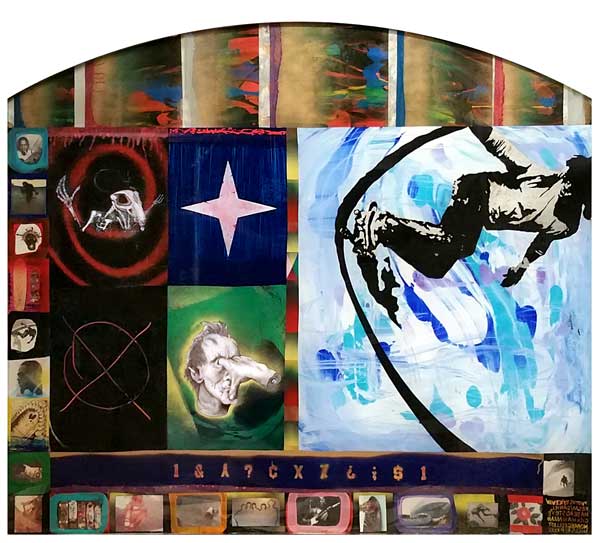The famous physicist Richard Feynman once said, “Men should study hard what interests them in the most undisciplined, irreverent and original manner possible.” Dave Tourje is a living example of this philosophy as he is interested in practically everything from hot rods to blues to quilting; it is this incredible fascination with the living, thriving world around him that fuels both his daily life and artistic practice.
Born and raised in Northeast LA, Tourje spent his youth submerged in punk rock, the surf and skateboard counterculture of the 1970s and early ’80s. It is this definitive boldness that infuses Tourje’s most recent paintings. These new works have a distinctive narrative thread, an impulse to tell a story, yet never reveal the entirety of any given narrative at once. Working in a largely forgotten technique called Reverse Painting, which began in China a thousand or so years ago, Tourje has the freedom to develop several central ideas simultaneously—similar to the way musicians lay down tracks individually, creating more complex relationships between sounds once they are organized into a cohesive unit. Tourje’s process embodies a number of art forms including music and film, and is reflected in his paintings’ tangential relationships between images.

Dave Tourje
He executive-produced the award-winning film Curly (2014), which chronicles the efforts of the Chouinard Foundation, founded with Robert Perine after Tourje purchased the home of Nelbert Chouinard in 1999. Chouinard was an influential art school and in the 1960s a creative hotbed, after which its remnants morphed into California Institute of the Arts.
Tourje’s paintings, mixed-media on acrylic glass, are persuasive on a number of levels. Because the content of the paintings is suggested rather than concretized by the images themselves, the viewer is encouraged to free associate—to invent relationships and scenarios that might inform the visual content wherein a painting like Soul Code 03 (The Rebel Dreams In Blue) becomes both a strange, unsettling nightmare and a beautiful dream of freedom. Tourje’s ever-present skeletal rat is both a symbol of “rat-rod” counterculture and the legendary Ed Roth’s iconic green “Rat Fink,” as well as a nod to artist Llyn Foulkes’ “Mickey Rat” and early skate culture. Tourje’s own rat is hip and cool, but he is also dead, as though only through dying and being reborn can he truly be most effective. The message here is once again veiled, but one can surmise that Tourje’s rat, along with others of his symbols, is, if nothing else, divinely, if not riotously, independent. Featured in the acclaimed California Locos event in Venice and Virginia Beach, the “Soul Code” series represents the latest renditions of his innovative style.



















>
way too god